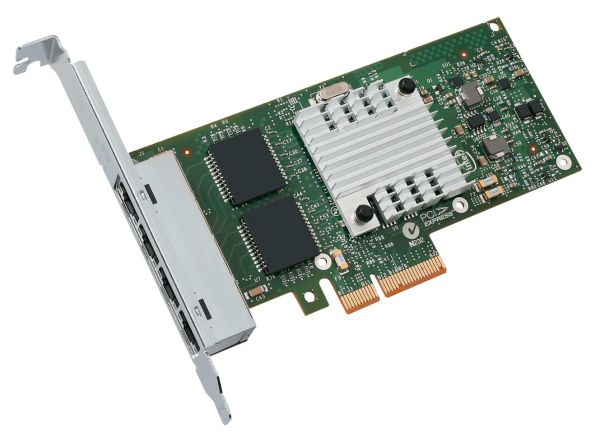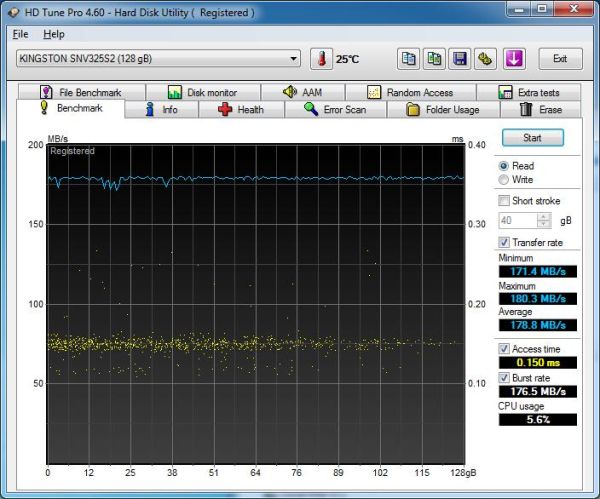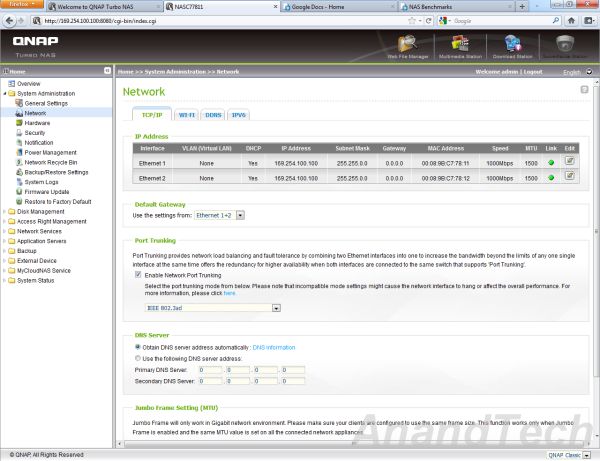QNAP TS-659 Pro II Review
by Ganesh T S on September 19, 2011 8:00 AM EST- Posted in
- IT Computing
- NAS
- QNAP
For the purpose of NAS reviews, we have setup a dedicated testbed with the configuration as below. The NAS is directly connected to the testbed (using as many Cat 5E cables as there are ports on the NAS) without a switch or router inbetween. This is done in order to minimize the number of external factors which might influence the performance of the system.
| NAS Benchmarking Testbed Setup | |
| Processor | Intel i5-680 CPU - 3.60GHz, 4MB Cache |
| Motherboard | Asus P7H55D-M EVO |
| OS Hard Drive | Seagate Barracuda XT 2 TB |
| Secondary Drive | Kingston SSDNow 128GB |
| Memory | G.SKILL ECO Series 2GB (1 x 2GB) SDRAM DDR3 1333 (PC3 10666) F3-10666CL7D-4GBECO CAS 7-7-7-21 |
| PCI-E Slot | Quad-Port GbE Intel ESA-I340 |
| Optical Drives | ASUS 8X Blu-ray Drive Model BC-08B1ST |
| Case | Antec VERIS Fusion Remote Max |
| Power Supply | Antec TruePower New TP-550 550W |
| Operating System | Windows 7 Ultimate x64 |
| . | |
In addition to the Realtek GbE NIC on-board the Asus P7H55D-M EVO, four more GbE ports are enabled on the system, thanks to the Intel ESA-I340 quad port GbE ethernet server adapter . With a PCI-E x4 connector, the card was plugged into the PCI-E x16 slot on the Asus motherboard.
Two of the four ports are teamed together as shown in the video below below during the benchmarking.
Intel NASPT is used to benchmark the NAS device. In order to ensure that the hard disk transfer rate is not a bottleneck, NASPT is run from the secondary drive in the testbed (the Kingston SSD). With average read and write speeds of 178.8 MB/s and 167.8 MB/s, it is unlikely that a single GbE link NAS can be limited in performance due to the test system. However, a link aggregated NAS could be affected. Fortunately, as we will see in the next few sections, this wasn't the case for the TS-659 Pro II.
All file copy tests were also performed using the SSD. The file copy test consists of transferring a 10.7 GB Blu-Ray folder structure between the NAS and the testbed using the robocopy command in mirror mode.
There are three important sharing protocols we investigated in the course of our evaluation of the TS-659 Pro II. In the next few sections, you will find NASPT / robocopy benchmarking results for Samba, NFS and iSCSI sharing protocols. Each section also has a small description of how the shares were set up on the NAS. The NASPT benchmarks were run in Batch mode thrice, giving us 15 distinct data points. The average of these 15 values is recorded in the graphs presented in the following sections. The robocopy benchmark was run thrice, and the average transfer rate of the three iterations is presented alongside the NASPT benchmarks.
The TS-659 Pro II supports multiple RAID configurations, but we believe that most of the users will end up running this in RAID-5. So, all our benchmarks are collected with the disks configured in a RAID-5 volume. The GbE ports were configured for dynamic link aggregation (802.3ad) as shown below:
Note that the 6 x 1 TB disks result in a total available space of arund 4600 GiB (shows up as GB on the NAS configuration webpage) when configured in RAID-5. This is due to a couple of maintenance partitions created by the QNAP firmware. Each 1 TB disk is partitioned as below.















69 Comments
View All Comments
meesterlars - Tuesday, September 20, 2011 - link
Sorry, Ganesh, I must have not seen that you had written the review.Yes, please do try and recreate the issues documented in the forum. Perhaps a little publicity from you guys would pressure QNAP into action.
IaninKL - Friday, May 25, 2012 - link
Hi Ganesh,I've just bought a TS-559Pro-II, so far just using it for a short-term project so have configured as JBOD and loaded about 6TB of data. 5*2TB Enterprise-grade drives.
I am wondering if the issue raised here was ever resolved?
The linked-page on the QNAP Forums has been taken down and there is no follow-up info on this thread either.
Cheers - keep up the great work!
QNAPSimon - Friday, September 23, 2011 - link
Thanks for bring this to our attention. We at QNAP are aware of the problem and have allocated dedicated resources to look into this. I will follow up on this and provide updates on our forum. If you have related concerns please email me.simonchang@qnap.com
Thanks
Hrel - Tuesday, September 20, 2011 - link
Quick search found 940 online. No hard drives inluded. Bahaha, no.MobiusStrip - Wednesday, September 21, 2011 - link
That's just ridiculous. There's no reason you should have to put drives in sleds. They should go in like cartridges, with a simple Eject button to remove them. Like these toaster-style drive docks:http://www.newertech.com/products/hdddocks.php
If locks are all that important, the lock could be above each slot and simply move a bar down to lock the drive in.
ZPrime - Friday, September 23, 2011 - link
In many systems, caddies help with noise isolation. I have several HP Home Servers and the caddies are plastic, but they have silicone/rubber grommets around a metal peg that attaches to the drives. They are tool-less, FWIW.Caddies can also help insure proper grounding. Depending on your chassis composition (some are plastic or have plastic rails), you might need some other way to get the body of the drive to ground to the chassis. Plastic caddy + metal inserts that connect to a metal latch or similar can solve this problem.
ZPrime - Wednesday, September 21, 2011 - link
Just because you have an LACP bonded connection between two machines does *NOT* mean that transfers will take full advantage of this. When you were testing for performance, did you run multiple simultaneous transfers?LACP / 802.3ad load balancing isn't as simple as people think. Bonding a pair of 1GB NICs doesn't give you "2GB of bandwidth."
Nenad - Friday, September 23, 2011 - link
In short: iSCSI >> SMB for small files and when file-cache can be usedI have QNAP TS-459 Pro+ and QNAP TS-419P , and I use them both with SMB and iSCSI.
In your test, performance of iSCSI is similar to SMB, even with write cache disabled in most parts.
But in my practice I find iSCSI has noticeably better performance in many cases, especially when you work with many small files. That can be seen on your test in 'DIR copy', but as just one number among dozen other it does not stand out. Unfortunately, it is mostly DIR copy where you need or notice speeds - copying single file will usually end fast regardless of SMB/iSCSI, video playback needs much smaller bandwith anyway etc ... it is copy of large folders with subfolders you need (and notice) speed.
Another area where iSCSI seems to have advantage is with using file-cache on windows. I'm not precisely certain how that works, but it appears that windows do not use caches so efficiently for networked/remote disk, as it does for 'local' iSCSI disk.
One practical application of this is anti-virus scanners, who tend to scan 'other' disk when you copy files - resulting in almost double time needed to copy file to/from QNAP, since for example first Norton read file from SMB share to scan, and then allows Windows to copy it locally. With iSCSI I see much smaller impact , and I believe that while Norton probably work same with reading file to scan, Windows can better use file cache to skip another reading when it needs to copy.
Carlu - Monday, October 3, 2011 - link
I love this small boxes, good power-performance ratio, but it sux when it comes to fulldisk crypto. nether the CPU has any good support for it, nor does it handles harddrives with inbuilt disk crypto. And for the same amount of money you get a 20W Xeon 20L, and a micro atx motherboard/chassi etc... and the Xeon has support for AES-IN instruction set...